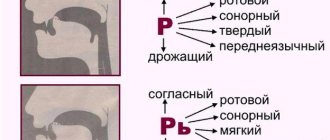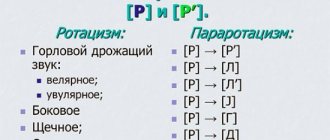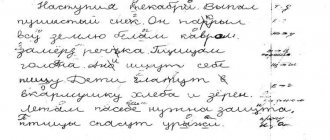Dysorthography is the inability to apply the known rules of the native language in writing. At the same time, the student’s oral speech and intellectual abilities can be at a fairly high level. In some cases, dysorthography is part of the symptoms of such a complex speech disorder as general speech underdevelopment.
It is difficult for a person who cannot competently express his thoughts in writing to achieve success in many areas of professional activity. However, the number of children with this problem is growing from year to year. A child with dysorthography can make up to 80 mistakes in one written work. Moreover, he does not see his mistakes and cannot correct them, although he may know the rules very well. In this case, experts say that the student lacks spelling vigilance.
The essence of the problem and symptoms of speech disorder
Specific skills that help you master the rules of the Russian language:
- rich vocabulary;
- ability to conduct morphological analysis of words;
- ability to choose test words.
The main age category of children suffering from dysorthography are primary and secondary school students, although this speech pathology also occurs in high school.
In addition to morphology, dysorthography suffers from syntax—observance of correct punctuation in writing. When spelling errors in writing become persistent, this leads to chronic failure of the child in many subjects.
Symptoms of the disorder:
- difficulties in mastering terminology, inability to understand and remember what a word, sound, syllable, sentence, verb, adjective, etc. is;
- memorizing spelling rules without understanding their meaning;
- inability to summarize the studied material, draw conclusions, retell the content;
- inability to give an example of a just learned rule and apply it in writing;
- selecting an identical-sounding word to test unstressed vowels, rather than a related word with the same root;
- inability to identify parts of a word: suffix, root, ending, prefix;
- lack or excessive punctuation in sentences.
The manifestation of dysorthography is based on the underdevelopment of mental functions responsible for the formation of specific skills necessary for mastering writing and competent written speech. This is due to the weakening of the child’s health, the consequences of minimal brain dysfunction (MCD) acquired in the prenatal, perinatal period, and in early childhood.
Other reasons for failure to master the rules of the native language:
- a consequence of general speech underdevelopment;
- a consequence of phonetic-phonemic underdevelopment of speech (FFN);
- violation of non-speech mental functions (memory, attention, switching from one type of activity to another, problems with synthesis and analysis);
- a combination of studying a large volume of material with an insufficient rate of development of mental functions;
- inability to master educational material at a fast pace, when errors occur under time pressure and do not occur when working at a slow pace.
In some cases, dysorthography occurs when there seem to be no obvious prerequisites for its occurrence. That is, the child is able to isolate sounds from a word, perform sound-letter analysis, distinguishes complex images, but makes mistakes due to the inability to concentrate, remember and reproduce the text dictated by the teacher.
Classification of dysorthography
The symptoms associated with this disorder are polymorphic. General manifestations of dysorthography are observed in the inability to use spelling rules and preserve the morphemic principle when writing all meaningful parts of a word. A child who does not have the necessary terminology and knowledge of the rules is found to have low quality spelling and a large number of spelling errors in the letter. Dysorphography has 3 degrees of severity: severe, moderate, mild. The degree is measured by the ability to perform a certain number of tasks, based on which a neuropsychologist or speech therapist determines the form of the deviation. Scientists also divide the disorder into categories, according to which the methodology and duration of correction are determined.
Main categories of dysorthography:
- Morphemic - implies a violation of the perception of the structural analysis of a word. Accompanied by a large number of spelling errors, determined on the basis of independent work (essay, presentation).
- Syntactic - incorrect application of the rules of syntactic writing (punctuation).
- Mixed - includes making mistakes in spelling and punctuation at the same time.
A good method for defining a category is through presentation. In most cases, the child makes mistakes in long words, rarely in short ones. There are fewer mistakes in dictations. Why? Because the student does not understand how to form the main idea. He is not able to separate the main events in the story from the unimportant ones. In his works there is no consistency in conveying the plot. Children suffering from dysorthography are often limited to only listing characters.
Types of dysorthography
There are several degrees of speech pathology. They depend on the difficulties students overcome, on the type of spelling in which they make the greatest number of errors:
- This group contains errors in spelling of a high degree of difficulty - paired and double consonants, an unstressed vowel at the root, an unpronounceable consonant.
- The second group contains spelling spellings of moderate severity - unverifiable words, capital letters in first names and patronymics, in the names of geographical objects.
- The third group contains easy spellings - indicating the softness of consonants in writing.
Dysgraphia: types, causes, prevention and treatment
A child masters written language by the time he enters school or directly in first grade. In order for this type of speech to be formed without any particular difficulties, it is necessary to master the basis of written speech.
This includes: 1. Correctly formed oral speech. The ability for analytical-synthetic speech activity: division into words, syllables, sounds, and synthesis. 2. Developed perception: spatial, visual-spatial gnosis, somato-spatial sensations, knowledge of the body diagram. 3. Formation of the motor sphere. 4. The ability to self-regulate. 5. Formation of abstract thinking.
If this basis is violated, then violations of written speech may occur.
There are 4 groups of writing disorders, which are determined by age specifics: 1. Difficulties in mastering writing. It occurs in the preparatory group at the age of 6–7 and in the first grade, and manifests itself in unclear knowledge of the alphabet. Children experience difficulties in translating sounds into letters, and in the transition from a printed letter to a written one, in addition, they experience difficulties in sound-letter analysis and synthesis.
2. Violation of the formation of the writing process. It occurs in grades 1–2 at 7–8 years old, when children mix printed and written letters, skip syllables and words.
3. Dysgraphia is a partial disorder of the writing process, which manifests itself in numerous persistent, repeated errors due to the immaturity of the higher mental functions involved in the writing process. The diagnosis is made by a speech therapist when the child has mastered the technique of writing, at 8–8.5 years.
Symptoms of dysgraphia:
- o when copying from a printed text, omission, replacement of letters, syllables, words and their fusion and splitting;
- o when dictating a text, the same thing is observed as in the first case + splitting and merging of sentences;
- o avalanche-like growth of errors;
4. Dysorphography. It is observed when a child does not know how to apply spelling rules, and numerous spelling errors are encountered in work.
Types of dysgraphia (depending on the causes of occurrence) Acoustic (occurs when phonemic perception is impaired).
Symptoms: manifested in substitutions of letters corresponding to similar sounds: whistling, hissing, voiced, voiceless, affricates and the components that make up them. In addition, it manifests itself in incorrect markings of softness in writing (PRISMO LUBIT, in mixtures of labialized vowels even in the stressed position (CLOUDS - TOCHA, FOREST - FOX).
The process of phoneme recognition includes various operations: • auditory speech analysis; • translation of the acoustic image into articulomes; • correlation of the acoustic-articulatory image with the phoneme, selection of the phoneme.
The insufficiency of any of these operations affects the entire process as a whole.
Articulatory-acoustic (occurs when sound pronunciation and phonemic perception are impaired).
Symptoms: substitutions, omissions corresponding to substitutions and omissions in oral speech (sometimes such errors can occur even after correction of oral speech). • replacing and mixing paired voiced and voiceless consonants (b-p, v-f, g-k, d-t, z-s, zh-sh); • replacement and mixing of whistling and hissing sounds (zh-sh); • replacement and mixing of affricates and components included in their composition (h - t'); • replacement and mixing of vowels of the first row and the second row, indicating the softness of consonants (a-ya, o-yo, u-yu); • omission of a soft sign when indicating the softness of a consonant; •replacement and mixing of vowels: o, u, e, i.
Agrammatic (the mechanism of the violation lies in morphological and syntactic generalizations). The following errors are observed: • distortion of the morphemic structure of the word; • replacement of prefixes and suffixes; • violation of the sentence structure; • changing case, pronouns and number of nouns; • violation of agreement.
Optical (occurs with impaired visual perception, as well as with imperfect visual and speech memory). Symptoms manifest themselves in substitutions and distortions of letters in writing: • graphically similar, consisting of identical elements, but differently located in space (v-d, t-sh); • including the same elements, but differing in additional elements (i-w, l-m, x-g); • mirror writing of letters; • tearing off elements of letters; • extra elements (bumps - shishshiki).
Dysgraphia due to impaired language analysis and synthesis (visual and speech memory suffers). Symptoms: • omissions of consonants when combining (dictation - ditant); • vowel omissions (dog - sbaka); • rearrangement of letters (tropa - rtopa); • adding letters (taskali - tasakali); • omissions, additions, rearrangements of syllables (stool-butaret); • violations of division of sentences into words.
Dysgraphia manifests itself in the combined spelling of words, especially prepositions, with other words (for example, the separate spelling of the word “po ran”). It is worth noting that written errors are not always a sign of a writing disorder. They may appear due to a special psychophysiological state (illness, fatigue, emotional stress, type of written work (for example, only on a test due to strong anxiety).
A few tips for parents: 1. If a child is assigned to read a text at home or write a lot, then break the text into parts and complete the task in several steps. 2. Do not force your child to rewrite homework many times; this will not only harm the child’s health, but also instill in him insecurity, and also increase the number of mistakes. 3. Praise your child for every success achieved.
Author of the article: Galimova Elena Anatolyevna
Methods for correcting the disorder
Usually, adults attribute a child’s poor performance to laziness and lack of diligence; parents turn to specialists too late.
Since speech disorders are based on underdevelopment of mental processes, it is better when several specialists are involved in correcting the defect:
- speech therapist;
- psychologist.
With the transition to the 3rd–4th grade, children are offered more complex types of activities to master their native language (composition, presentation), so the number of errors in schoolchildren with dysorthography increases many times, which leads to a drop in academic performance and low grades in the diary.
To facilitate the acquisition of spelling rules, children are offered a system of sequential grammatical actions, each of which is reinforced separately. Only after firmly mastering one operation do they move on to the next stage. The teacher is not limited to one type of training; in parallel, he uses grammatical generalizations to create a stable system of his native language.
Examples of exercises offered in speech therapist classes:
- choose adjectives for the noun (domestic bird, bright, gray, fast, shy; the sea is blue, calm, warm, salty, endless);
- select nouns for the verb (snow is falling, leaves, vase, stone, ball) and vice versa (the lemon is ripe, the apple is ripe, the plum is ripe, the fruit is ripe);
- find all the words with the same root in the picture (forester, timber carrier, forest belt, forest);
- guess the picture and explain the guessed expression (“nod off”);
- collect objects in pairs, choose a generalizing word for them (elephant-zebra animals of hot countries, question who?);
- combine words into phrases;
- name an object, knowing its parts (beak, legs, wings - bird (who?);
- name the required noun by analogy (uncle and ... aunt, son and ... daughter);
- name the place of work (cook - kitchen, doctor - hospital) or the necessary tool (scissors - hairdresser, brush - painter);
- write as many words as possible with the same vowels, for example, “O” (crow, gold, good, etc.);
- encrypt the stressed vowel in a word with schemes;
- arrange the pictures under gender symbols (cat - masculine, cow - feminine, sun - neuter);
- form an adjective from a noun (a gold ring is golden, but not golden, plum jam is plum, not plum or creamy).
At the same time, work is being done to develop memory, attention, thinking, and imagination. Specialists teach children self-control skills, improve oral speech, and the ability to act according to a certain algorithm.
The video below provides an example of how this can be done:
Causes
All possible causes of spelling disorders are divided into 3 groups:
- Medical.
- Mental.
- Pedagogical.
Typically, dysorthography occurs due to the impact of several negative factors on the child. The most common reasons include:
- Erased dysarthria, dyslalia.
- General speech impairment of 1-4 degrees.
- Dysgraphia.
- Lesions of the central nervous system of various etiologies.
- Pedagogical neglect.
- Psychosomatic weakness.
- Attention deficit.
- Delayed mental development.
- General lethargy.
- Mental overload.
The risk group consists of children who have a history of:
- Dysphagia and dyslexia (during primary school).
- Prenatal and postnatal pathology - disorders that arose from the moment of fertilization of the egg until the birth of the child or from the time of maturation of gametes until their fertilization, and complications that arose during the period of breastfeeding the child.
- Minimal brain dysfunction, encephalopathy, accompanied by neurological symptoms.
- Phonetic underdevelopment of speech, phonetic-phonemic underdevelopment of speech.
Tips for parents
The main thing that parents can do for their child is to create a favorable psychological climate for him during correctional work. The schoolchild is already under the pressure of the situation, and his mood is often not the most rosy, and then adults traumatize the child by constantly pointing out his speech errors.
The consequence of this may be that the child will become withdrawn, and instead of the communication he so needs, speech will slow down its development, will not improve and be enriched, which will lead to problems of social adaptation in the team. Therefore, it is important to show patience and forbearance to resolve the situation successfully.
Prevention
Main preventive rules:
- Our task as parents is to be attentive to our child. Take an interest in his school life, relationships with friends and teachers.
- Make sure he follows the curriculum and does his homework regularly.
It will be a plus if the school has a well-established collaboration between primary school teachers, speech therapists and child psychologists. Early identification of deviations in the acquisition of spelling rules and further work with the child by the last two specialists will allow the child to quickly overcome problems and return to effective learning on a par with peers.
Dysorthography, along with other disorders of the writing process, is increasingly being diagnosed in children of primary school age, but timely correctional and pedagogical assistance will prevent children from further failure to master the material, reduce the number of errors and compensate for school failure.






